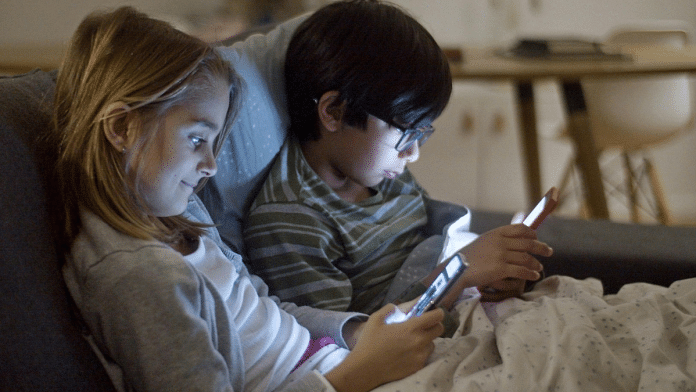“A lmost every great truth that we get from the ancients about how to live a better life, to become a better person – ‘judge not lest ye be judged’; ‘be slow to anger, be quick to forgive’ – the online life, the social media life, the phone-based life, tells us to do the opposite.” These are the words of Jonathan Haidt, professor of ethical leadership at New York University and author of The Anxious Generation: How the Great Rewiring of Childhood Is Causing an Epidemic of Mental Illness. Speaking on the World Economic Forum’s Radio Davos podcast , Haidt describes his book as “an attempt to explain why it is that the students entering my college classes and everyone’s college classes in 2014-15 were so different from millennials”.
The Anxious Generation makes the case for keeping smart phones out of schools – an idea that has gathered momentum around the world since the book was published a year ago. But Haidt says it’s not just adolescents suffering from what he calls an addiction to this technology. “For most of us, our attention has been drained away.

And if you don’t have your attention, you’re not going to amount to much in life, you’re not going to get much done,” Haidt says. His solution? “Change your daily habits. Turn off most notifications.
Regain your attention.” One way to achieve this, he says, is to mark a “digital Sabbath” – a day each week when you don’t use, or completely minimize your use of, digital technology. “It really helps if you have a community or at least a few friends to do it with,” Haidt adds.
“You’ll find yourself just much more open to actually having a long conversation or a long meal and not rushing off to check something.” Here are some of the other highlights from Haidt’s interview on Radio Davos. New technologies have often met with disapproval from older generations, who worry about the impact on the young, but for Haidt, an unprecedented change has been ushered in with smartphones.
“Imagine if when we went to school, they said, you can bring in your television set, your VCR, your guitar, whatever you want. Bring it in, play with it during class. That’s completely insane.
You wouldn’t be able to learn anything. And that’s what’s happened since 2012.” “Television is really, really different [from smartphones],” Haidt says.
“The dose makes the poison. There were kids who watched ten hours a day and I bet they were messed up. But you and I probably watched one to three hours a day, and then you’d go outside.
We couldn’t watch TV for ten hours a day. But when you go from a flip phone to a smartphone, you can. And half of all teens in the United States say they are online almost all the time.
“Imagine if when we went to school, they said, you can bring in your television set, your VCR, your guitar, your paint by numbers, Play-Doh, whatever you want. Bring it in, play with it during class. That’s completely insane.
You wouldn’t be able to learn anything. And that’s what’s happened since 2012.” Academic performance has plunged since 2012 – five years after the release of the first smartphone and around the time when sales really started to accelerate.
Programme for International Student Assessment (PISA) scores show drops in performance in all the core subjects. “ When schools go phone-free, what they all say is that they hear laughter in the hallways again. Because for the last ten years, it’s been mostly kids just staring down.
” “[PISA scores] were rising from the 1970s through to 2012, and then they began to fall,” Haidt says. “In response, some schools, and France did this first, said ‘We’re going to ban phones’. “When schools go phone-free, and this is happening around the world, what they all say is that they hear laughter in the hallways again.
They say the lunchroom is loud again. Because for the last ten years, it’s been mostly kids just staring down. And this is a big reason why they are so lonely.
” This surge in loneliness correlates to what Haidt describes as an “instantaneous international collapse” in mental health since the arrival of the smartphone. “[It] goes haywire,” he says. “Not just in the US, but in Australia, New Zealand, Scandinavia, many, many countries.
” “ We’ve got to get our kids to stop being so stimulated, because when kids are stimulated for half the day, the other half of the day is painfully boring. The dopamine circuits are like: ‘Wait, where’s our stimulation?’ ” The best response is obvious, in his eyes: “The biggest thing they can do for teen mental health is follow Australia’s lead: raise the age to 16 for social media . “ Brazil is going phone-free [in schools] .
Indonesia say they’re going to follow Australia’s lead [and] raise the age [for social-media use]. They haven’t said what age, but I’m hoping 16.” For Haidt, raising age limits is far more effective than tweaking algorithms to try and protect teenagers online.
“We’ve got to get our kids to stop being so stimulated, because when kids are stimulated for half the day, the other half of the day is painfully boring. The dopamine circuits are like: ‘Wait, where’s our stimulation?’ So we’ve got to basically reduce the amount of time kids are spending on the internet and on screens by 70%, 90% when they’re young.” In terms of encouraging children to use their phones less, language is key to making it feel less painful, according to Haidt.
“What I found is that here in Europe, people just love the word ‘ban’. Everyone wants to talk about this as a ‘phone ban’. Whereas, in America, we don’t like bans unless they’re absolutely necessary, and so we call it a ‘phone-free school’.
It’s a positive, it’s a virtue, so phone-free schools is what we need to have.” Another key differentiation to be aware of is that a smartphone is very different from a traditional phone. “A smartphone is not a phone.
It’s a multi-entertainment portal,” Haidt says. “If all kids had a flip phone, they wouldn’t be on it all day long. They’d be saying: ‘Meet you at three at the pizza parlour,’ and then they would meet and that would be great.
” This takes us back to ancient wisdom, which Haidt tells us has a clear message: “Try to calm the buzzing cacophony in your mind. Sit quietly and you’ll get an inner harmony between your mind, your spirit and the world.” Individual inner harmony is one thing, but something bigger is also needed to reduce some of the potentially negative impacts that smartphones and social media have had on all of us.
“This is a collective action problem,” Haidt says. “When you try to do it alone, it’s very hard. What we need are clear norms that we can all follow, and they’re not that hard if we do them together.
We’re making amazing progress.” Ian Shine is a Senior Writer at Forum Stories, and Robin Pomeroy is Podcast Editor at World Economic Forum. This article is republished from the World Economic Forum under a Creative Commons license.
Read the original article . var ytflag = 0;var myListener = function() {document.removeEventListener('mousemove', myListener, false);lazyloadmyframes();};document.
addEventListener('mousemove', myListener, false);window.addEventListener('scroll', function() {if (ytflag == 0) {lazyloadmyframes();ytflag = 1;}});function lazyloadmyframes() {var ytv = document.getElementsByClassName("klazyiframe");for (var i = 0; i < ytv.
length; i++) {ytv[i].src = ytv[i].getAttribute('data-src');}} Save my name, email, and website in this browser for the next time I comment.
Δ document.getElementById( "ak_js_1" ).setAttribute( "value", ( new Date() ).
getTime() );.
Health

Smartphones are causing a mental health pandemic. Anxious generation needs weekly digital detox

Academic performance has plunged since 2012 – five years after the release of the first smartphone and around the time when sales really started to accelerate.















